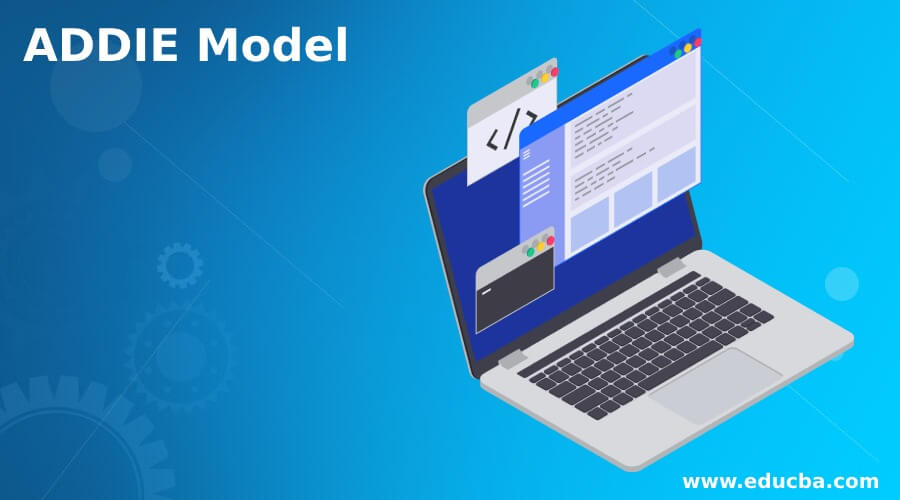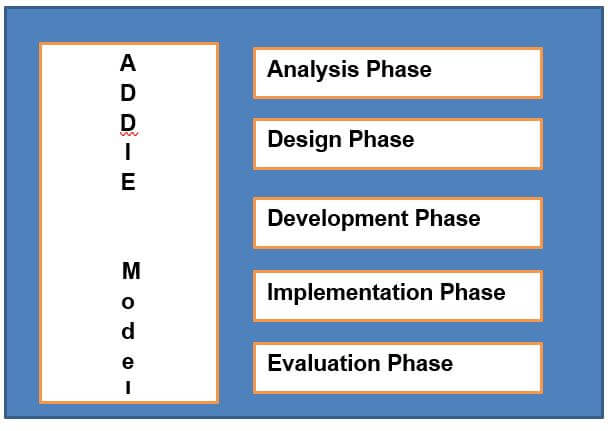Updated March 30, 2023
Introduction to ADDIE Model
In the training of developers and instructional designers, the ADDIE model is commonly in use. It will help to build the training developers model. For building, there are five different steps. The steps are Analysis, Design, Development, Implementation, and Evaluation. Every step is having its own significance. While considering the ADDIE model, we need to consider these 5 steps. With the help of this model, we are able to design flexible and dynamic effective models for the training and the support tools. But while designing such types of models, we need to design in such a way that there are no weaknesses or loopholes in it.
How ADDIE Model Works?
The ADDIE model is nothing but an ISD (Instructional Systems Design) model. Currently, most instructional design models are using the ADDIE model. There are lots of different models available in the market like Carey, Dick Kemp ISD models. As per the requirement or the need, we need to use a specific model. There are different features available as per the model, but the common acceptance of these models is rapid prototyping.
This will help for the formative feedback or continual while we are working on the material created. This type of model will save a good amount of cost and time. It will help to catch the problems and will help to fix the problems. For the design of the instructional materials, the instructional theory will play an important role. There are different theories like social learning, behaviourism, cognitivism, constructivism, etc. will help to give the shape for defining the instructional materials. In the ADDIE model, each step in the model has an output that will feed to the subsequent steps.
The list of phases will depend on the previous steps; the hierarchy will be Analysis Step > Design Step > Development Step > Implementation Step > Evaluation Step.
1. Analysis Phase
In the analysis phase, we are clarifying the instructional problem. Then, the instructional goals and the instructional objective will establish. Next, we are identifying the learner existing knowledge, learning environment and skill identity. This is the initial step and very important step. Here, we are gathering a number of information on the problem statement.
While working on the analysis phase, we need to work on the below questions.
- Who will be the audience?
- What are the characteristics of the audience?
- How do we need to identify the new behavioural outcome?
- What are different types of learning constraints exist?
- What are the different types of learning constraints not exist?
- What are the different types of delivery options?
- Which are the different online pedagogical considerations available?
- How much time will it need to complete for the project completion?
2. Design Phase
In the design phase, there are multiple aspects that we need to consider. While working on the design phase, we need to consider the steps, i.e. the exercises, media selection, content, assessment instruments, lesson planning, subject matter analysis, learning objectives, etc. In the ADDIE Model, the design phase is very important. The design phase should be systematic and specific.
In other words, the systematic steps mean it should be identifying the correct order method, proper logical format, good developing strategies and the evaluating a set of planned strategies. These design steps will help to meet the project goals. In the design phase, the specific means of each of the steps or the elements on the design phase should be executed with the proper attention to detailed steps.
Below are the lists of steps that will involve in the design phase.
- We need to detail the visual of the project, documentation of the project instructional, detail technical design plan, etc.
- We need to apply the instructional strategies based on the intended behavioural outcomes (with the help of the domain) and also consider the psychomotor, cognitive, affective, etc.
- We need to create the storyboards.
- We need to design the user experience and the user interface.
- We need to create a detailed prototype.
- We need to apply the proper visual design. So it will also include graphic design also.
3. Development Phase
In the development phase, we are doing the actual development of the project. Here, the developer will create and assemble the project components as per the design stage. Then, the developer will work on the development and/or technologies integration. Finally, the tester or the QA will be revised or reviewed as per the feedback.
4. Implementation Phase
In the implementation phase, we need to work on the procedure for the training, and the learners are development. We need to cover the course curriculum method, method of delivery, learning outcomes, testing procedure steps, etc. Here, we are implementing the detailed solution on top of the project uses case. We need to make sure that all the requirements should be frozen and meet the entire requirement.
In this implementation phase, the project manager should ensure that the tools, hands-on equipment, CD-ROMs, books and the software. The learning application or the website should be functional and 100% productive.
5. Evaluation Phase
In the evaluation phase, there are two major parts like the formative and summative. In the evaluation phase, the formative evaluation is the first stage and it will be present at each stage of the ADDIE process. In the second summative evaluation stage, we are taking the feedback from the end-users.
Advantages and Disadvantages of ADDIE Model
Given below are the advantages and disadvantages mentioned:
Advantages
- Flexibility: In the ADDIE Model, we are getting more flexibility to work.
- Easily modifiable: In the ADDIE Model, we can easily modify the changes.
- Used in other or different models: We also easily use the same ADDIE Model in the different models.
Disadvantages
- Linear: In the ADDIE Model, we are having a number of phases in it. Every phase is having its dependency on the previous phase.
- Too detailed: The method, planning and process are too much detailed and lengthy.
- Time consuming: It will consume a huge amount of time for building the project with the help of the ADDIE Model.
Conclusion
We have seen the uncut concept of the “ADDIE Model”. The ADDIE Model is used by the training developers and instructional designers.
Recommended Articles
This is a guide to ADDIE Model. Here we discuss the introduction, how ADDIE model works? advantages and disadvantages, respectively. You may also have a look at the following articles to learn more –




